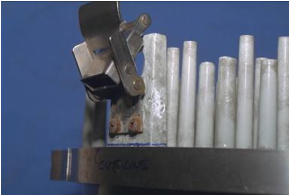Corrosion From Outdoor Exposure

Figure 1. |
It is well known that corrosion can weaken structures over time. But because corrosion rates can differ significantly from location to location, it is difficult to predict the amount of weakening that can occur for a particular structure used outdoors in a given location. Over the years, standardized salt fog testing has been used to predict how structures degrade over time resulting from exposure. While these tests give guidelines on conducting accelerated tests, they provide no insight as to the real world exposure level corresponding to a test condition, i.e. an acceleration factor.
Small screw fasteners that had been exposed in service for 2 years in a marine environment were visually compared to similar fasteners subjected to salt fog testing for varying lengths of time up to 22 days. The subject corroded screws are shown in Figure 1. An acceleration factor for this service was determined, and found to be consistent with corrosion rate research conducted for other marine environments. Research of corrosion rates in other marine environments found that they can vary significantly, and are most strongly dependent on temperature, wind speed and direction, and rainfall.
Mechanical testing of the screws removed from service, and those subjected to the accelerated weathering conditions, provided a method to predict the amount of time necessary for the screw strength to drop below an acceptable level.
